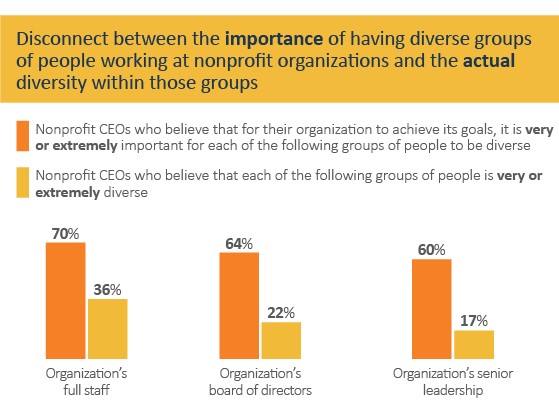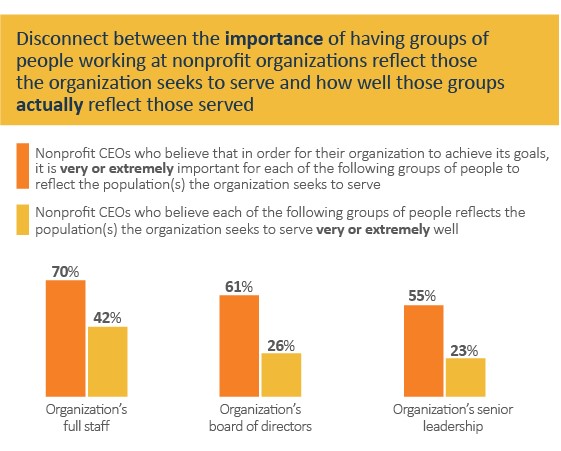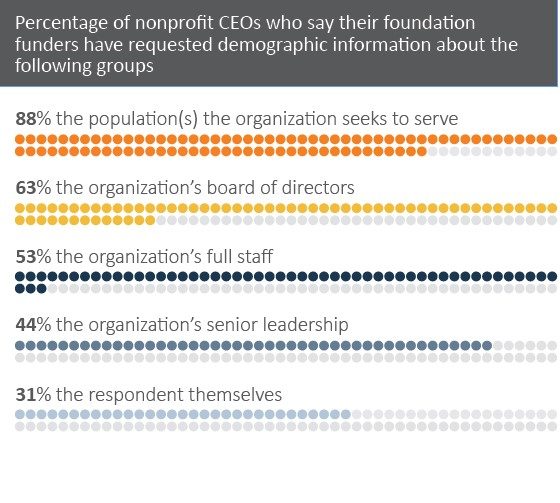CEP‘s new research report released today, titled Nonprofit Diversity Efforts: Current Practices and the Role of Foundations, shares nonprofits’ perspectives on diversity in their work and what their needs are.
Initially, we set out to conduct a study on diversity, equity, and inclusion at nonprofits. But given the expansiveness and complexity of these topics, we quickly realized that this was too much to cover in a single study. So, we started with diversity, using D5’s definition:
Diversity: the demographic mix of a specific collection of people, taking into account elements of human difference, but focusing particularly on:
- Racial and ethnic groups: Asian Americans and Pacific Islanders, Hispanics/Latinos/Latinas, African Americans and blacks, and American Indians and Alaska Natives
- LGBT populations
- People with disabilities
- Women
Since much of the talk about diversity among foundations focuses on nonprofits, it’s important to lift up the grantee perspective to ensure that nonprofits’ needs and perspectives on their diversity efforts are heard and understood. With that in mind, we surveyed our Grantee Voice panel of nonprofit leaders earlier this year about diversity at nonprofits and how foundations can be most helpful in this area. The panel is comprised of nonprofits from across the country, with annual expenses ranging from $100,000 to $100 million. We sent surveys to 338 nonprofit CEOs and received responses from 205, for a response rate of 61 percent. The top five issue areas nonprofits in this study are focused on are education, social justice, community and economic development, human services, and health.
The report shares an array of data on topics related to diversity, but a few data points in particular stood out to me.
Room for Improvement
Nonprofit leaders recognize that they have room for improvement in terms of how diverse they believe their staffs and boards should be in order to achieve their organization’s goals versus how diverse they currently are — and they also recognize they have steps to take to better reflect the populations they are serving, and that it’s important for them to do so.
For example, while 64 percent of nonprofit CEOs believe that in order to achieve their organization’s goals, it’s very or extremely important for their board to be diverse, only 22 percent believe their board is very or extremely diverse. And, while 61 percent of nonprofit CEOs believe that in order to achieve their organization’s goals, it’s very or extremely important for their board to reflect those they seeks to serve, only 26 percent of CEO’s believe their boards are reflecting those populations very or extremely well.


Perceptions of Diversity
When it comes to race and ethnicity, 79 percent of nonprofit CEOs rate their organization as at least somewhat diverse; only 17 percent rate their organization as extremely diverse. Eighty-five percent find their organization reflects the populations they seek to serve at least somewhat well on race and ethnicity, but only a quarter think they reflect the population they seek to serve extremely well.
In terms of disability, 41 percent of nonprofit CEOs say their organization is at least somewhat diverse. That means the majority of nonprofit CEOs who responded to our survey — 59 percent — believe their organization is not very diverse or not at all diverse when it comes to disability. Sixty percent of nonprofit CEOs find that their organizations reflect the populations they seek to serve at least somewhat well when it comes to disability. Only 11 percent of nonprofit CEOs believe their organizations are reflecting the populations they seek to serve extremely well when it comes to disability.
In our survey, we also asked nonprofit leaders about how diversity factored into their hiring practices. Just over half of nonprofit CEOs said their organization requests that search firms provide a diverse candidate pool. Only seven percent say they redact information such as names, addresses, or educational backgrounds from resumes before they are reviewed.
Views of What Foundations Are — and Aren’t — Doing
Less than half of nonprofits — 42 percent — told us that their foundation funders have not discussed diversity issues with them. One-third of nonprofit CEOs said when diversity is discussed, it’s in relation to both their organization’s internal operations and programmatic work.
While 42 percent of nonprofit CEOs say they don’t want foundations very involved — or involved at all — in their organization’s diversity efforts, 17 percent want them very or extremely involved. And how they want foundations involved varies, too.
Some would like nonmonetary support for trainings, or to learn about best practices. Others would like monetary support to aid in their efforts. As one nonprofit CEO writes, it’d be helpful to have “best practice sharing — workshops, webinars, challenges — as well as some funding to help support the learning that we’ll need to do to get there!” Another would like foundation funders to “help fund staff recruitment efforts and salaries that would help attract a diverse pool of candidates.” Yet another would appreciate help “finding ideal board candidates, especially a group of diverse board candidates,” citing that as “a constant challenge.”
This tells us that there is no one solution to how foundations can support nonprofits in their diversity efforts. There needs to be communication between foundations and nonprofits about what is needed and what would be most helpful when it comes to diversity at any given nonprofit.
Most respondents told us that foundations have requested demographic information from their nonprofit. The most frequent request, from 88 percent of nonprofits, is for demographic information about the population(s) their organization seeks to serve.

But while funders are collecting demographic data, it’s less clear what they’re doing with it. Of the nonprofits that report providing demographic data, only 21 percent say that their foundation funders explain how they use that information.
There is much more data on nonprofits and diversity to dig into in the report we released today. We hope that the data proves useful for foundations and nonprofits alike, and that it sparks more conversation between the two about how and why diversity is essential for the effectiveness of nonprofits and their foundation funders — and what is needed for the road ahead.
Ellie Buteau is vice president, research, at CEP.
Download Nonprofit Diversity Efforts: Current Practices and the Role of Foundations here.


